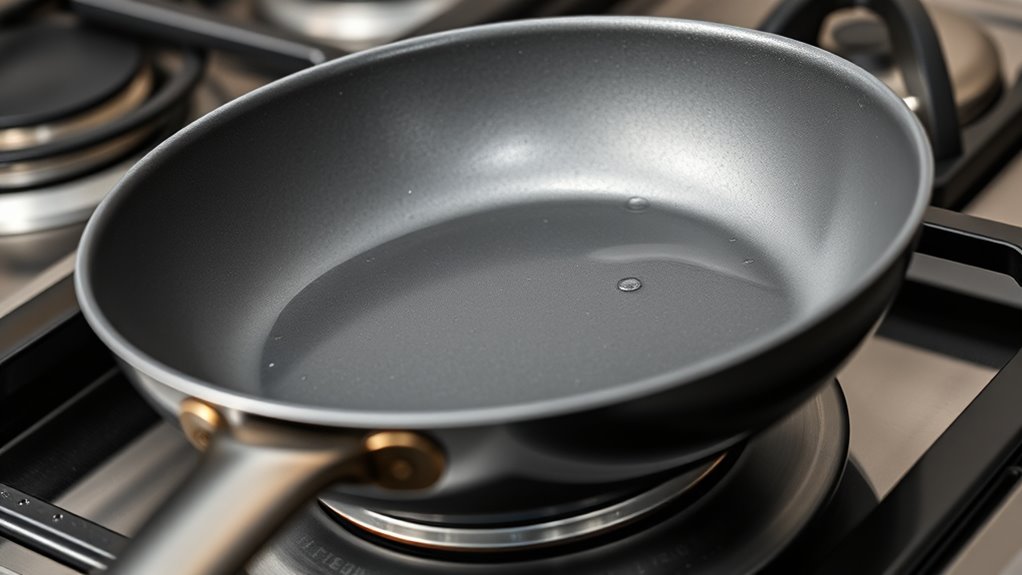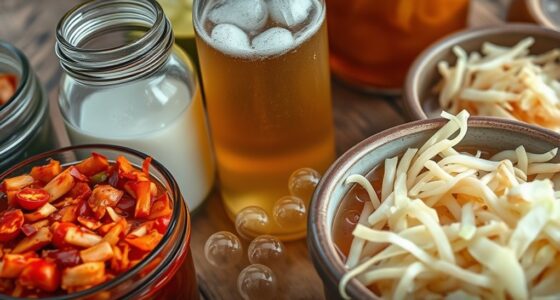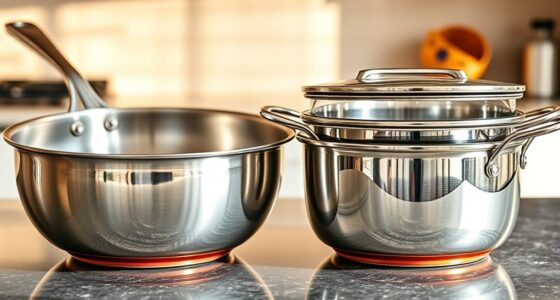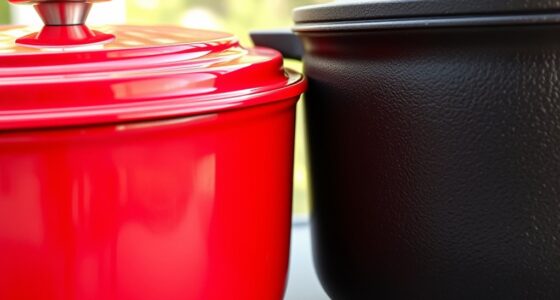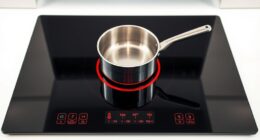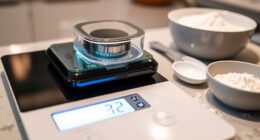PTFE, commonly known as Teflon, offers excellent nonstick performance and durability but can release toxic fumes if overheated above 500°F. Ceramic coatings, made from natural minerals, tolerate higher temperatures and are PFOA-free, but tend to chip or wear faster. Both require proper care, like avoiding metal utensils and controlling heat, to extend their lifespan. Stay tuned to discover how to choose the best option for your cooking needs.
Key Takeaways
- PTFE (Teflon) provides excellent nonstick performance and durability but risks toxic fumes if overheated above 500°F.
- Ceramic coatings are made from natural minerals, tolerate higher temperatures, but tend to chip or wear faster than PTFE.
- Proper care—low to medium heat, non-metal utensils, gentle cleaning—extends the lifespan of both PTFE and ceramic nonstick cookware.
- PTFE coatings typically last 1-2 years, while ceramic coatings often need replacement within 6 months to a year due to wear.
- Choosing between PTFE and ceramic depends on safety preferences, heat resistance needs, and maintenance willingness.
Composition and Types of Nonstick Coatings
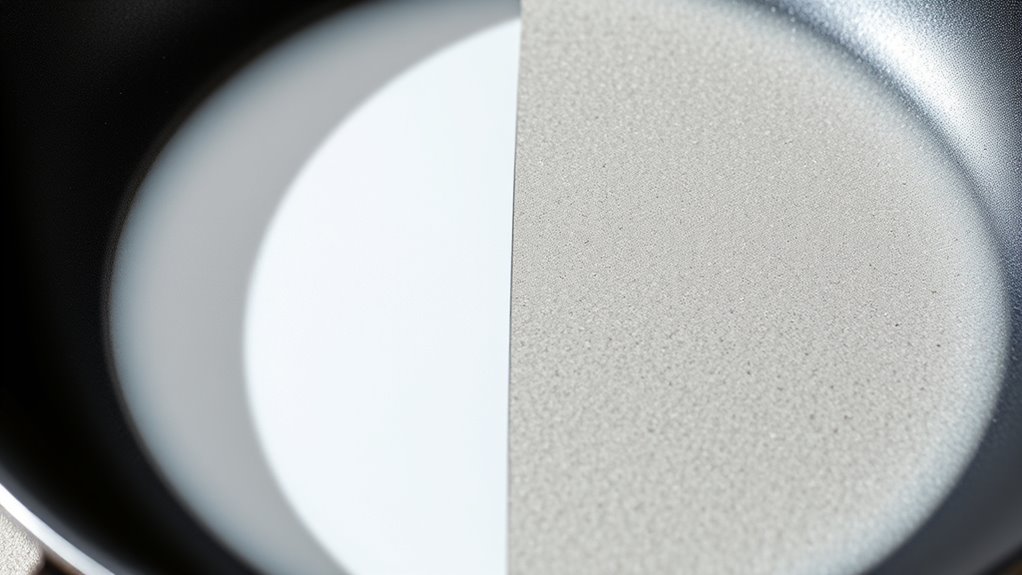
Nonstick coatings come in two main types: PTFE and ceramic. PTFE, or Teflon, is a synthetic polymer created through polymerization of tetrafluoroethylene, forming a smooth, nonstick surface. It typically features multiple coating layers that enhance its nonstick properties, making it easy to cook with and clean. Ceramic coatings, on the other hand, are made from natural minerals like silicon dioxide, applied via the sol-gel method and baked onto cookware surfaces. These coatings are free from PFOA and PTFE, offering an alternative nonstick surface. The cookware’s overall composition influences each coating’s performance; PTFE coatings are flexible and withstand high temperatures, while ceramic layers are more brittle and may wear faster. Both types serve different needs based on their material properties and manufacturing processes.
Safety Considerations for PTFE and Ceramic Surfaces

You need to be aware that overheating PTFE coatings above 500°F can release toxic fumes, which may harm you and your pets. Scratches and wear on the surface can cause small chemical particles to escape, risking food contamination. Properly using low to medium heat and avoiding metal utensils helps keep both PTFE and ceramic surfaces safe and intact. Additionally, understanding remote hackathons can provide insights into innovative cookware solutions developed by global teams. Incorporating AI in Business insights can also help manufacturers develop safer and more durable non-stick coatings through advanced analysis and innovation. Being aware of material safety standards is essential for ensuring the cookware you choose remains safe during regular use. Regular maintenance and inspection of the surface can help detect wear and tear, which is crucial for maintaining safe cooking conditions. Moreover, selecting cookware with compatible surfaces ensures optimal performance and safety during cooking.
Overheating Risks
Overheating cookware can pose serious safety risks, especially with PTFE and ceramic nonstick surfaces. When PTFE pans exceed 500°F, they release toxic fumes that can cause flu-like symptoms or more serious health issues. Ceramic coatings are more heat-resistant but can crack or degrade if exposed to sudden thermal shock or high temperatures beyond manufacturer limits. Overheating risks include coating degradation, reduced nonstick safety, and increased nonstick surface wear. To avoid hazards, always keep cookware below recommended temperature limits and prevent preheating empty pans. Additionally, understanding thermal limits of these coatings can help prevent accidental damage and ensure safe cooking practices. Being aware of industry standards for these materials can further guide safe usage and prolong the lifespan of your cookware. Recognizing material properties helps in selecting the appropriate cookware for various cooking methods and avoiding overheating scenarios.
Surface Damage Concerns
Surface damage to PTFE and ceramic cookware raises safety concerns because compromised coatings can expose underlying materials and release harmful particles or fumes. Damage such as surface wear, scratches, chipping, or cracks can weaken the coating’s surface integrity. This exposes materials that may pose health risks if ingested or inhaled. Common causes include thermal shock, impact damage, or harsh cleaning. Specifically:
- Surface scratches or chips degrade the nonstick coating.
- Chipping exposes underlying materials, increasing safety risks.
- Thermal shock from rapid temperature changes worsens coating wear.
- Repeated impact can cause coating degradation and flaking.
- Proper surface maintenance and handling are essential to prevent damage and ensure safety.
Once the coating is damaged or flaking, using the cookware becomes unsafe, as particles or chemicals may be released, heightening health hazards. Protecting surface integrity is vital for safe cooking. Additionally, advances in AI-driven solutions could enhance the development of more durable coatings, reducing the risks associated with surface damage. Regular inspection and proper handling can help maintain coating durability and ensure safe usage over time. Proper cleaning techniques also play a crucial role in preventing surface deterioration and extending the lifespan of non-stick surfaces. Recognizing signs of damage early can help prevent potential health risks related to exposure to degraded coatings.
Performance and Durability of Different Nonstick Materials

When choosing nonstick cookware, you’ll notice PTFE coatings resist scratches better and withstand higher temperatures, making them more durable over time. Ceramic coatings, while good at heat retention, tend to chip or wear out faster with regular use. Understanding these differences helps you pick a material that matches your cooking habits and extends its lifespan. Additionally, the application of high-quality airless paint sprayers in renovation projects demonstrates the importance of durable and efficient tools for achieving professional results. For example, Versatile heating solutions like heat pumps can enhance energy efficiency and comfort in your home, making it easier to maintain optimal indoor conditions year-round.
Coating Wear Resistance
The wear resistance of nonstick coatings varies considerably depending on the material used. PTFE coatings are durable, resisting hundreds of thousands of nonstick cycles, but scratches and high heat impact can accelerate coating wear and degradation, shortening their lifespan. Ceramic coatings tend to be more brittle, leading to faster ceramic coating wear—often within 6 months to a year—and are more susceptible to chipping and metal utensil damage. Proper care markedly enhances nonstick surface longevity. To maximize nonstick durability:
- Avoid metal utensils.
- Use low to medium heat.
- Hand wash gently.
- Regularly inspect for signs of coating degradation.
Following these practices helps maintain coating wear resistance, extending the lifespan of both PTFE and ceramic nonstick cookware.
Heat Tolerance Limits
Understanding the heat tolerance limits of nonstick cookware is essential for maintaining their performance and safety. PTFE limits typically cap at around 500°F, and exceeding this can cause coating degradation and fumes that pose health risks. PTFE coating can emit potentially harmful fumes when overheated, so proper temperature control is crucial. Additionally, some types of nonstick coatings may have different heat tolerance specifications, making it important to follow manufacturer guidelines. Ceramic cookware, on the other hand, usually tolerates higher temperatures—up to 600°F or more—helping it withstand high-heat cooking methods better. This makes ceramic a more suitable choice for searing and broiling. Proper temperature control is key to preventing damage and preserving the structural integrity of both nonstick coatings. Pushing PTFE coatings beyond their heat tolerance can lead to breakdown and unsafe fumes, while ceramic coatings generally maintain their nonstick properties at high temperatures. Knowing these limits allows you to cook safely and extend the durability of your cookware. Additionally, staying informed about AI Security developments can help ensure the safe deployment of kitchen technology in the future. Understanding heat tolerance limits also assists in selecting the right cookware for specific cooking techniques and ensuring long-lasting performance.
Long-Term Performance
Both PTFE and ceramic nonstick coatings gradually degrade over time due to repeated heating, utensil contact, and cleaning. This wear and tear affects coating lifespan and nonstick durability. Here’s what you should know:
- PTFE coatings typically last 1-2 years with proper care, resisting PTFE degradation and maintaining heat resistance longer.
- Ceramic coatings, being more brittle, often chipping or scratching within 6 months to a year, reducing cookware longevity.
- Regular maintenance tips, like avoiding metal utensils and gentle cleaning, can help delay coating deterioration and support coating renewal.
- To maximize nonstick performance, replace cookware when signs of chipping or uneven wear appear, ensuring excellent nonstick properties and safety.
- Understanding the performance and durability of different nonstick materials can help you choose cookware that lasts longer and performs better.
Proper Use and Care for Nonstick Cookware
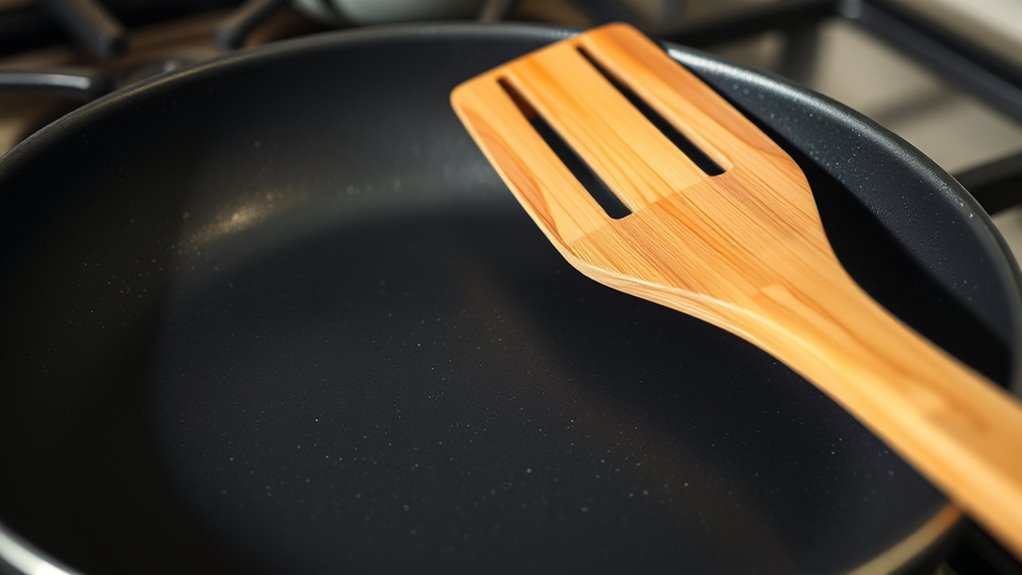
To keep your nonstick cookware in top condition, it is essential to use it correctly and handle it with care. Proper use involves heating your nonstick surface on low to medium heat to prevent coating damage and reduce the risk of harmful fumes. Always choose non-metal utensils like silicone or wood to protect the coating’s durability, whether you have PTFE-coated or ceramic pans. Good cookware care also includes gentle cleaning methods—hand wash with non-abrasive scrubbers and avoid harsh detergents. Avoid thermal shock by not transferring hot pans into cold water. Regularly oil the surface lightly to maintain slip and prevent wear. Proper heat management and utensil compatibility ensure safe cooking and extend the lifespan of your cookware’s nonstick coating. Silicone utensils are especially recommended for their gentle interaction with delicate coatings. Additionally, being aware of cookware material properties can help you select the best cookware for different cooking needs and prolong its lifespan.
Comparing Benefits and Drawbacks of PTFE and Ceramic Coatings
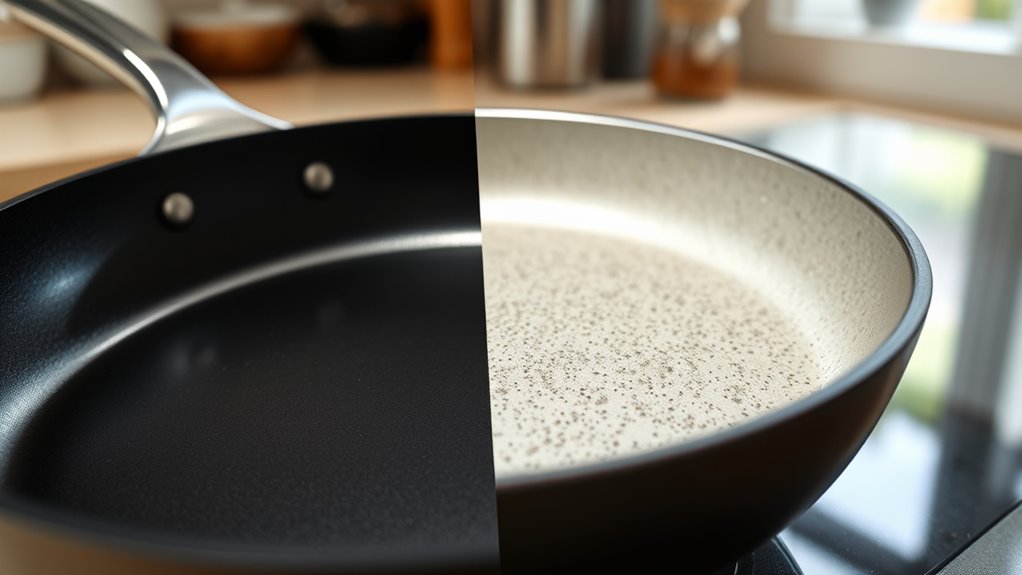
When choosing between PTFE and ceramic coatings for nonstick cookware, it’s important to weigh their benefits and drawbacks.
- PTFE offers excellent nonstick properties and durability, resisting scratches and maintaining performance longer with proper care, but it can release toxic fumes if overheated above 500°F.
- Ceramic coatings, made from natural minerals and PFOA free, withstand higher temperatures up to 600°F and are generally safer at high heat, but they tend to wear out faster and are more prone to chipping.
- PTFE’s durability makes it better for long-term use, whereas ceramic coatings are more brittle, affecting their wear and tear over time.
- Your choice depends on balancing durability, safety, and maintenance, with PTFE being more resilient and ceramic offering a chemical-free alternative.
Making an Informed Choice for Your Kitchen Needs
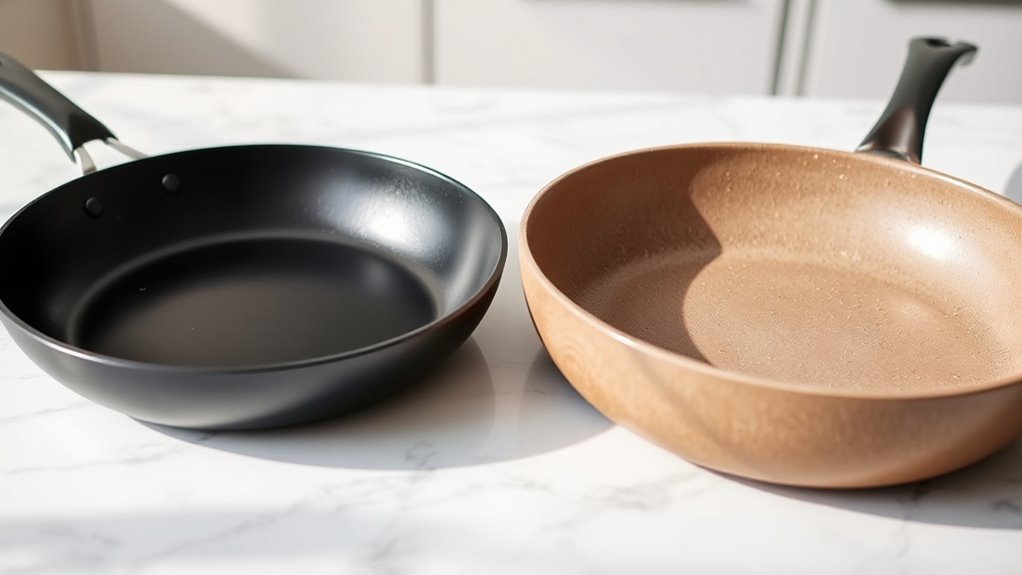
Choosing the right nonstick cookware depends on your safety concerns, cooking style, and how often you’re willing to replace your pots and pans. PTFE coatings deliver excellent nonstick performance and durability but can emit toxic fumes if overheated above 500°F. Ceramic coatings, made from natural minerals and PFOA-free, are safer at high temperatures but tend to wear out faster. To maximize safety and lifespan, practice proper cookware care by avoiding metal utensils and high heat. Your cooking techniques also matter—gentle heat preserves ceramic coatings, while careful heat management extends PTFE cookware’s durability. Consider how often you’re comfortable replacing your cookware and your heat resistance needs. Your choice should balance safety, durability, and maintenance, ensuring you find the best nonstick solution for your kitchen.
Frequently Asked Questions
Is PTFE Non-Stick the Same as Ceramic Non-Stick?
You’re wondering if PTFE non-stick is the same as ceramic non-stick. They aren’t identical; PTFE coatings like Teflon are synthetic and very slippery, with a lower heat tolerance. Ceramic coatings are mineral-based, glass-like, and typically safer at higher temperatures. While PTFE tends to last longer, ceramic is more eco-friendly and PFOA-free, but may wear out faster. Your choice depends on durability, safety, and cooking temperature preferences.
Is Ceramic Cookware PTFE and PFOA Free?
Imagine your grandmother’s cast iron skillet—today’s ceramic cookware is much more modern. Yes, ceramic cookware is generally PTFE and PFOA-free because it’s made from natural mineral-based silica compounds. Unlike traditional nonstick coatings, it doesn’t contain fluoropolymers or harmful chemicals. Just be sure to check labels, as some lower-quality options might have additives or hybrid coatings. Overall, ceramic cookware offers a safer, non-toxic non-stick experience.
Does Calphalon Ceramic Have PTFE?
You’re wondering if Calphalon ceramic cookware contains PTFE. Most Calphalon ceramic pans are made with a ceramic nonstick coating derived from natural minerals, which means they’re usually PTFE-free. However, some models might have PTFE underneath or alongside the ceramic layer. To be sure, check the product details or labeling—look for claims like “PTFE-free” or “PFOA-free” to confirm your specific pan’s composition.
Is PTFE Safe in Non-Stick Pans?
You wonder if PTFE in non-stick pans is safe. When used properly within the recommended temperature (up to 500°F), PTFE is generally safe, as regulatory agencies like the FDA approve it for cookware. However, avoid overheating or scratching the surface, which can release fumes or increase chemical exposure. Keep your cooking at low to medium heat and use gentle utensils to guarantee safe, long-lasting performance.
Which Is Better, Ceramic Nonstick or Nonstick?
You’re wondering which is better, ceramic or nonstick cookware. Ceramic pans are safer since they’re free from PTFE and PFOA, and they handle high heat without fumes, making them ideal for health-conscious cooks. However, they wear out faster and need replacing sooner. Nonstick pans with PTFE last longer and offer easier food release, but you need to avoid overheating. Choose based on your priorities: safety or durability.
Conclusion
Choosing between PTFE and ceramic is like selecting the right key for your culinary symphony. PTFE offers smooth performance, while ceramic brings natural harmony. Your cookware’s coating is the silent conductor—guiding your kitchen routines with safety and durability. By understanding these materials, you hold the baton to craft meals with confidence and care. Ultimately, your choice shapes not just what’s on your plate, but the melody of your everyday cooking.
